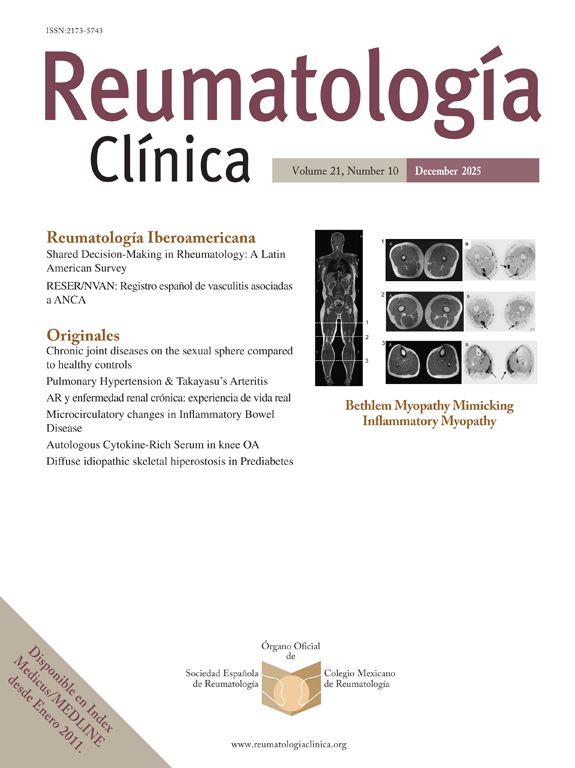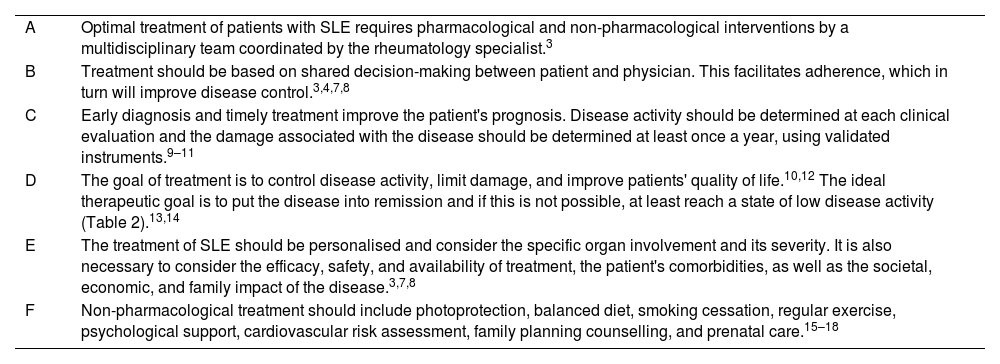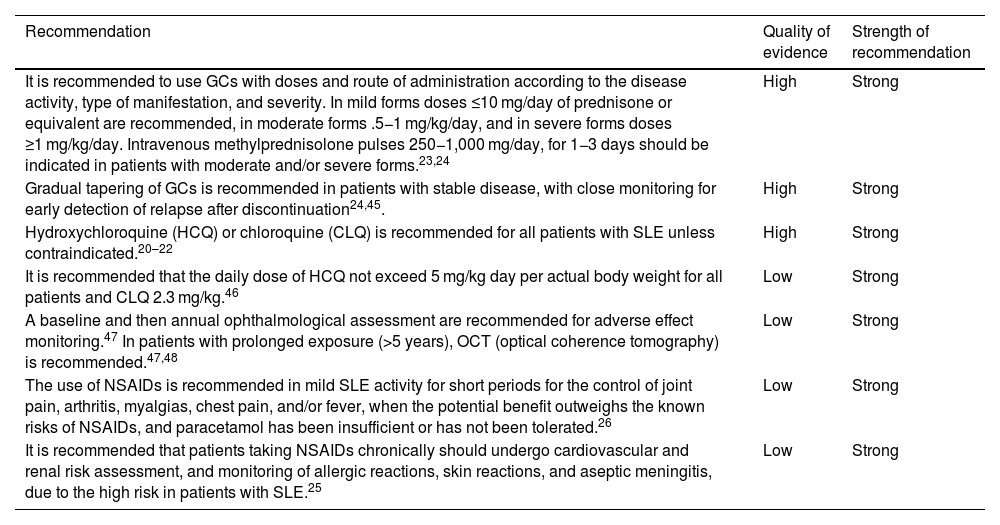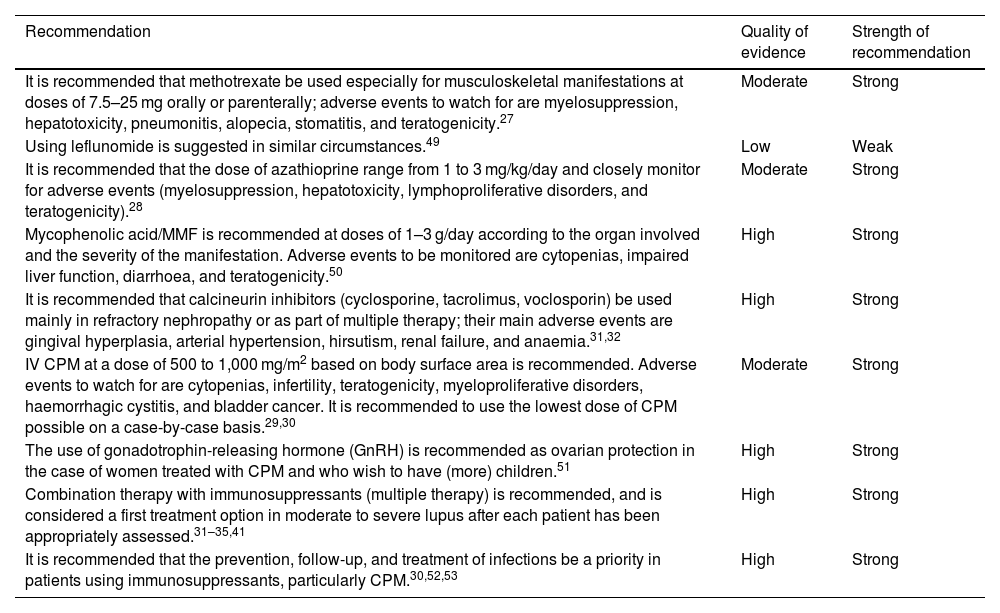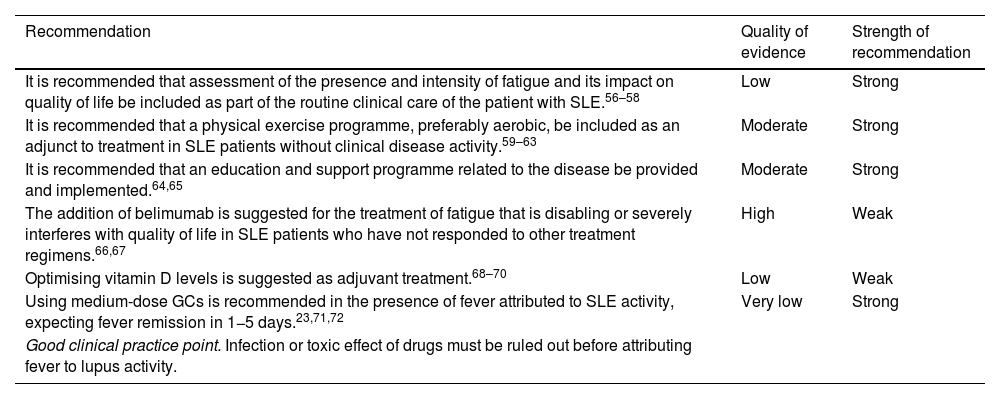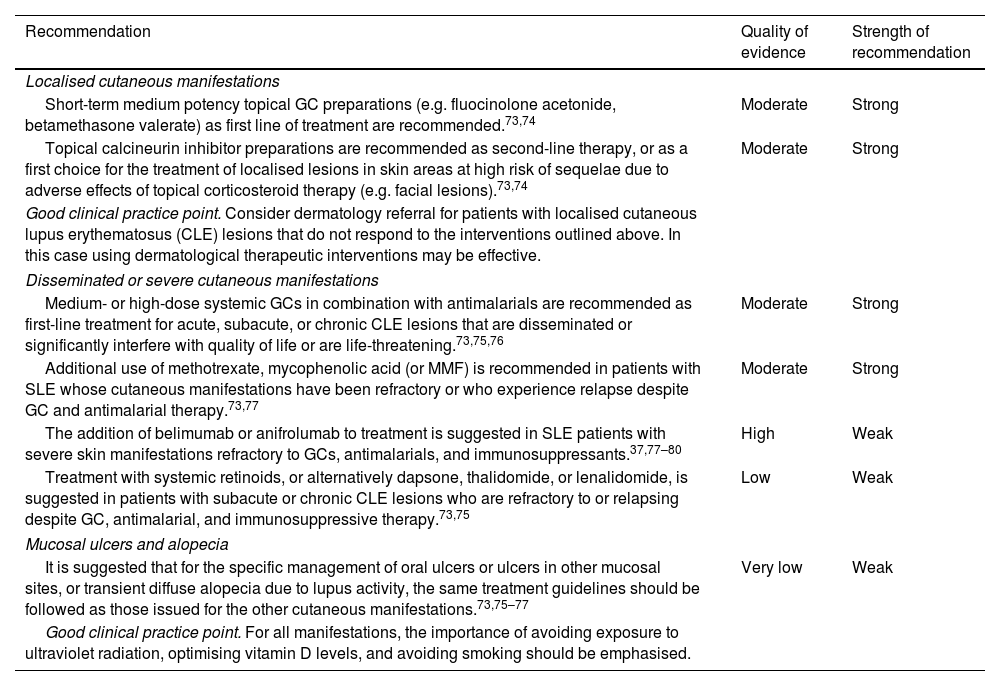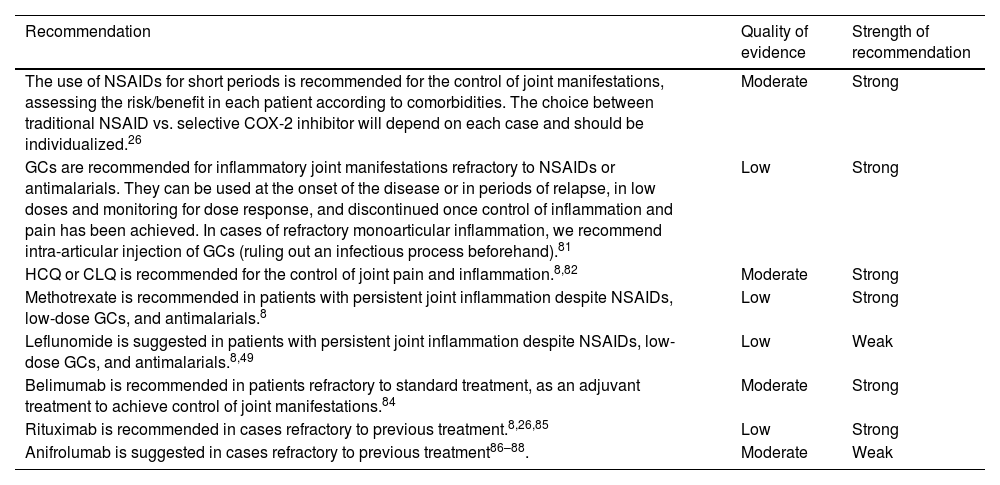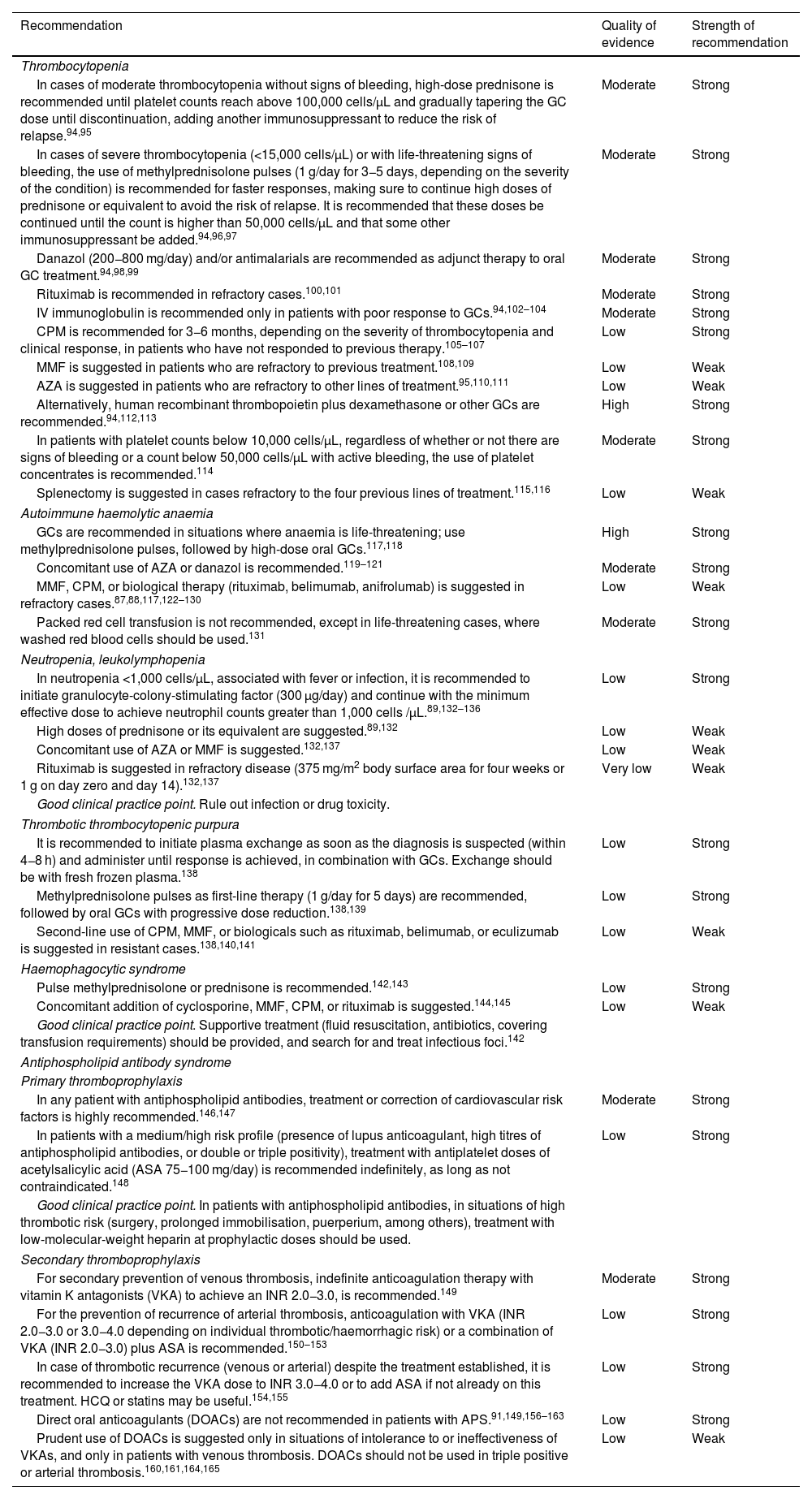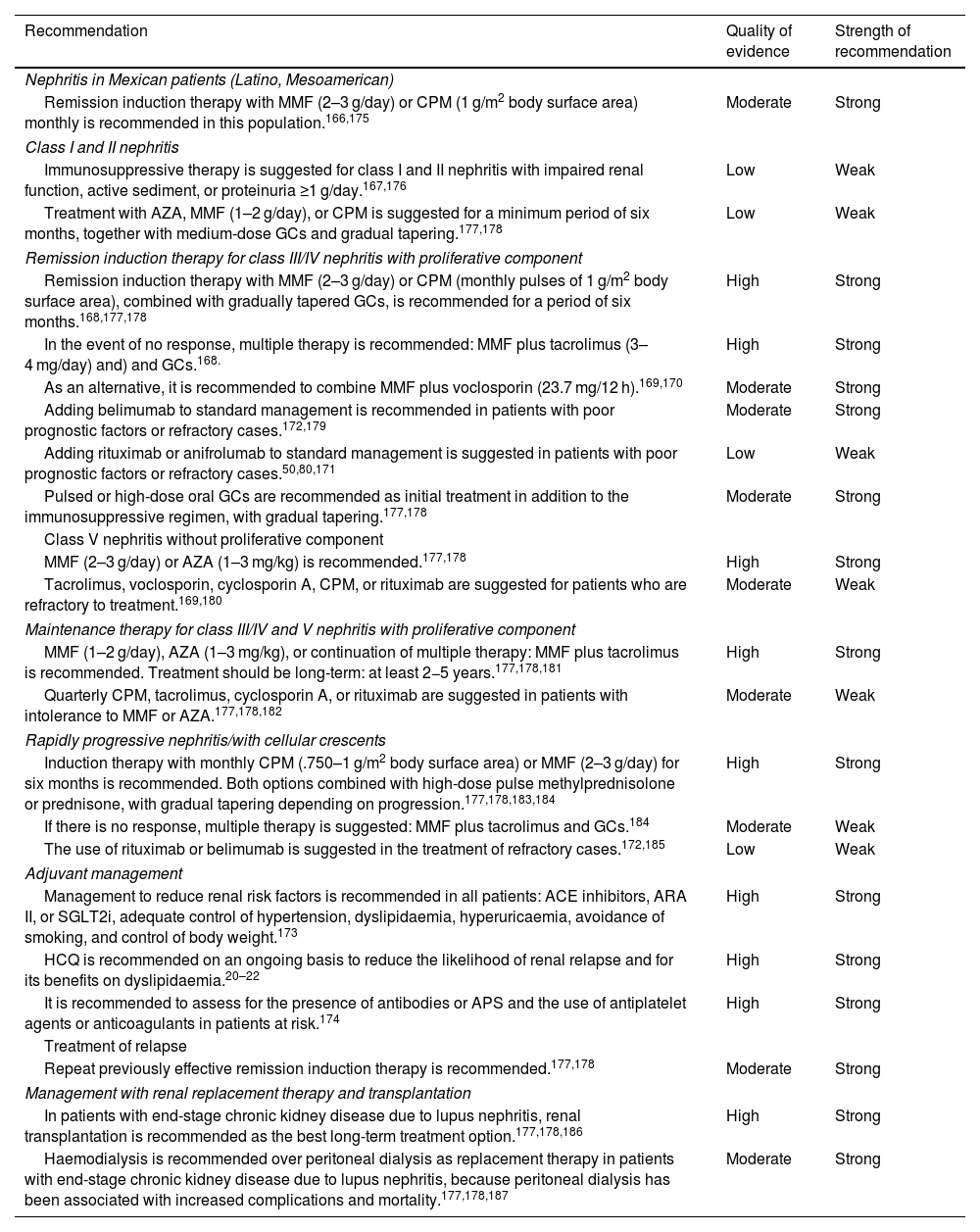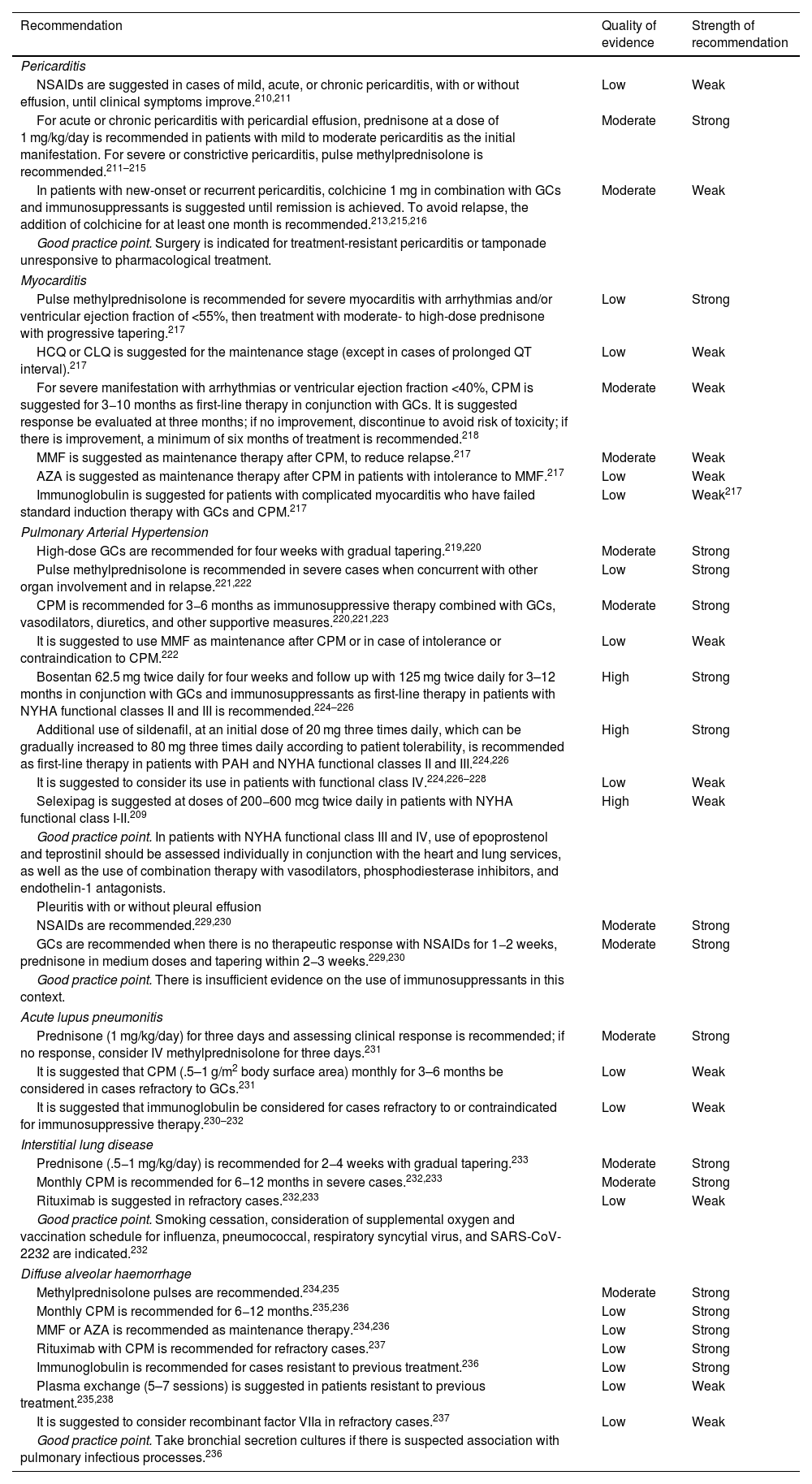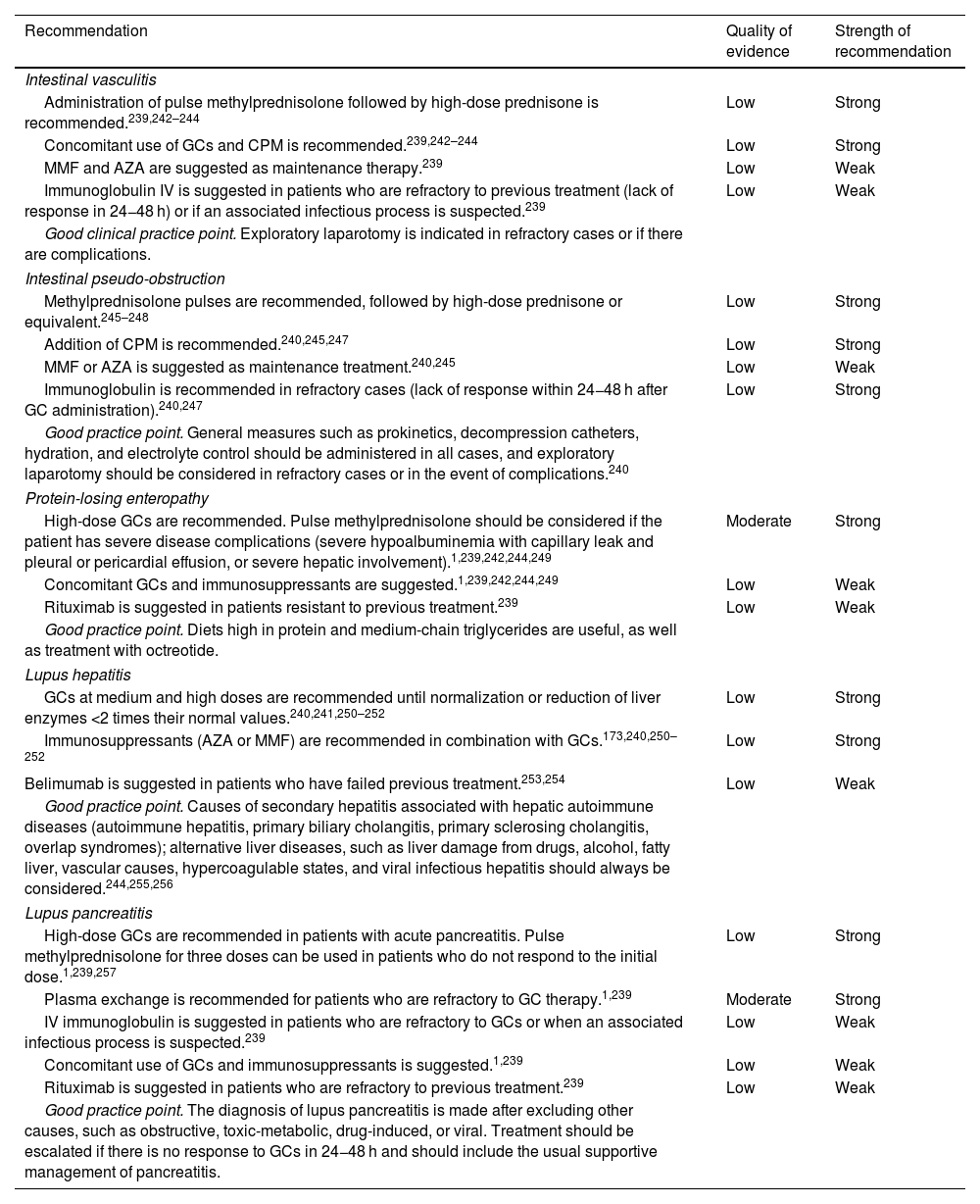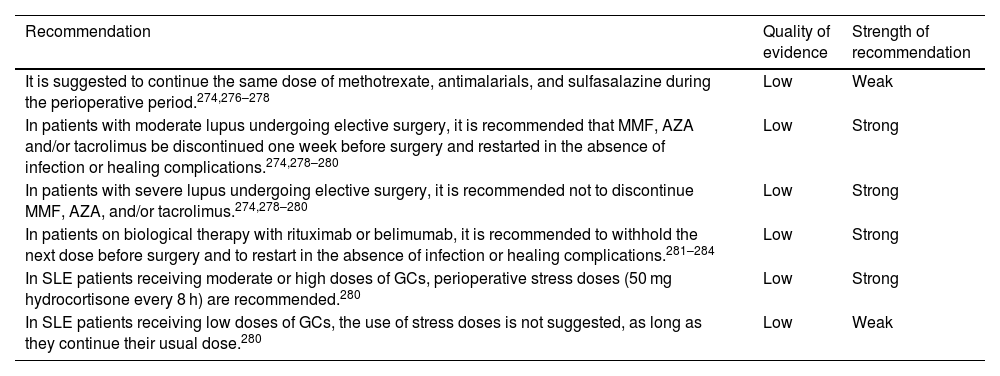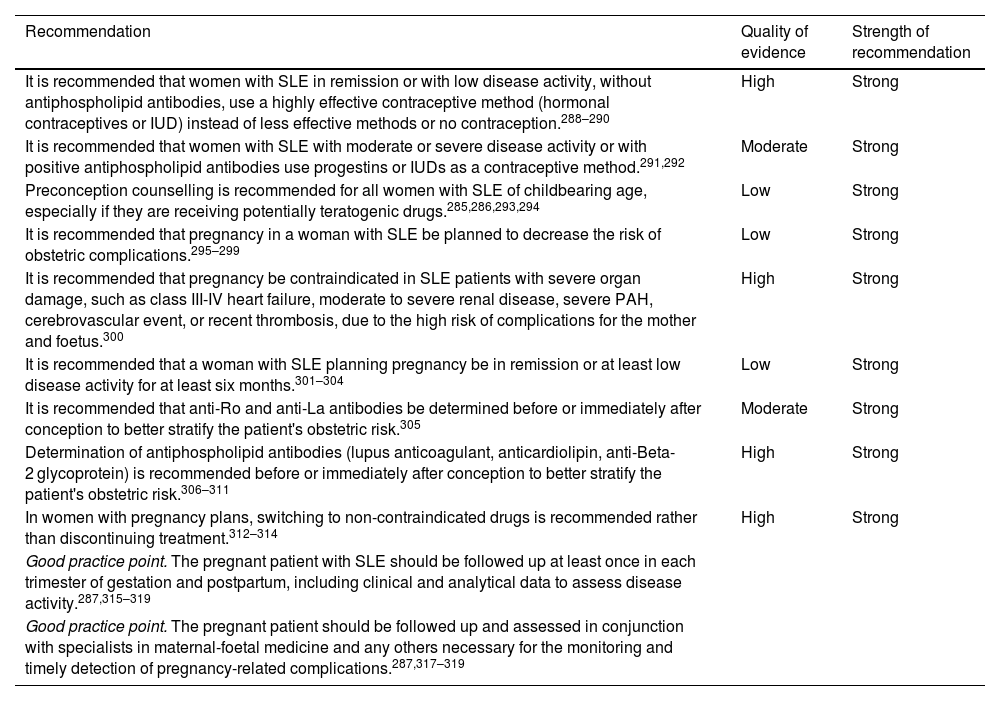Herein we present the update for the Mexican Guidelines for the Treatment of Systemic Lupus Erythematosus.
It involves the participation of several experts along the country, following the GRADE system.
We included aspects regarding vaccines, pregnancy and cardiovascular risk which were not presented in the previous guidelines in 2017.
Presentamos la actualización de las Guías de Práctica Clínica para el tratamiento del lupus eritematoso sistémico del Colegio Mexicano de Reumatología elaboradas por un grupo de expertos en la enfermedad tanto a nivel privado como gubernamental, de acuerdo con la metodología GRADE.
Se incluyen por primera vez aspectos sobre vacunación, embarazo y riesgo cardiovascular.
In 2017, the Mexican College of Rheumatology published the first Clinical Practice Guidelines (CPG) for the treatment of Mexican patients with systemic lupus erythematosus (SLE) and committed to update them periodically.1
CPGs are an extremely useful tool to guide physicians on the treatment of a specific disease and require a strict methodology in their development and implementation. Therapeutic guidelines need to be updated when new drugs emerge with sufficient evidence to support their use, or when the indications change for drugs that are already in use.
SLE is a prototypical autoimmune disease, in terms of both its complexity and heterogeneity. Currently, the therapeutic strategy aims to achieve specific targets and, as much as is possible, limit accumulated damage, especially when secondary to drugs used in the treatment of the disease. Given the characteristics of SLE patients, recommendations should include general patient management, specific treatment of target organ manifestations, and monitoring of comorbidities arising from both treatment and disease. It is also important to consider genetic and ethnic factors (such as the higher severity observed in Mestizos), as well as access to health systems and appropriate therapies.
This paper includes topics that were not covered in previous guidelines, such as treat-to-target, cardiovascular risk, and treatment during pregnancy and lactation. In addition, all recommendations for drug groups and organ- and system-specific manifestations are updated.
MethodologyA working group of 40 rheumatologists, all certified and active members of the Mexican College of Rheumatology, with experience in the treatment of patients with SLE and professionally active in different institutions and regions of the country, in both private and governmental practice, was formed to undertake this update. Two medical experts in CPG methodology were also involved.
The expert panel met for the first time remotely in September 2023. At this meeting, the methodology was defined, and the content of the guidelines was divided into four sections: 1. General considerations, 2. Drugs, 3. Treatment by organ and system, and 4. Special situations. Specific working teams were formed for each of the subtopics and together they reviewed and updated the research questions using the PICO format (patient, intervention, comparison, outcomes), developing those that corresponded to topics not included in the previous recommendations.2
A systematic review of the literature was conducted covering information published since 2017. All articles from PubMed, Cochrane Central Register of Controlled Trials (CENTRAL), Google Scholar, and SCIELO published between January 2017 and December 2023 were taken into account for this update (considering that previous guidelines had included publications up to December 2016). Articles published from January 2010 onwards were considered for de novo questions.
All study designs were included, with priority given to meta-analyses, clinical trials, cohort, case-control, and cross-sectional studies. However, case reports, narrative reviews, or consensus studies were considered in the case of research questions with very limited information or where there were no papers of sufficient quality.
Each team received the PICO search mechanisms from the methodologists, which were adapted to the topic allocated. The articles were then reviewed, and the search was completed based on those that were related and the references consulted. The articles selected were those that provided clear answers to the research questions posed. The findings from the eligible studies were synthesised in evidence tables, using the GRADE (Grading of Recommendations Assessment, Development, and Evaluation) approach.2 From the evidence tables, adjustments were made to previous recommendations or new recommendations were developed, grading the level of evidence and strength of each recommendation as per the GRADE system.
All initial recommendations were sent for review and suggestions to the team, who provided feedback. Disagreements were resolved by discussion among team members.
In January 2024, a hybrid meeting was held with the entire research team to review each of the recommendations issued, deliberate, and establish the degree of consensus, resulting in the final version. Recommendations were accepted with more than 80% agreement; in cases where this figure was not achieved, they were analysed and amended as necessary, repeating the vote to achieve consensus or to establish that consensus had not been reached.
RecommendationsThis update of recommendations for the management of SLE is structured as follows:
- 1
General principles for management of the disease.
Recommendations:
- 2
On the indications for and monitoring of the main groups of drugs used in SLE.
- 3
For the specific treatment of the disease in the different organs and systems.
- 4
For special situations that are important because of their impact on SLE, such as the perioperative period, vaccination, pregnancy, and cardiovascular risk.
The general principles of treatment in SLE encompass the concept of comprehensive management of a very complex disease. They highlight the role of the rheumatologist as the leader of the multidisciplinary care team and the importance of regular patient assessment. They emphasise the need for an end goal of treatment (remission or low disease activity) and relapse prevention as the primary means to reduce progression and long-term damage. They consider the importance of non-pharmacological measures, as well as the selection of drugs based on their increased efficacy, safety, and availability. They also stress that the patient should always be involved in therapeutic decisions.3–6 (Tables 1 and 2)
General principles.
| A | Optimal treatment of patients with SLE requires pharmacological and non-pharmacological interventions by a multidisciplinary team coordinated by the rheumatology specialist.3 |
| B | Treatment should be based on shared decision-making between patient and physician. This facilitates adherence, which in turn will improve disease control.3,4,7,8 |
| C | Early diagnosis and timely treatment improve the patient's prognosis. Disease activity should be determined at each clinical evaluation and the damage associated with the disease should be determined at least once a year, using validated instruments.9–11 |
| D | The goal of treatment is to control disease activity, limit damage, and improve patients' quality of life.10,12 The ideal therapeutic goal is to put the disease into remission and if this is not possible, at least reach a state of low disease activity (Table 2).13,14 |
| E | The treatment of SLE should be personalised and consider the specific organ involvement and its severity. It is also necessary to consider the efficacy, safety, and availability of treatment, the patient's comorbidities, as well as the societal, economic, and family impact of the disease.3,7,8 |
| F | Non-pharmacological treatment should include photoprotection, balanced diet, smoking cessation, regular exercise, psychological support, cardiovascular risk assessment, family planning counselling, and prenatal care.15–18 |
SLE: systemic lupus erythematosus.
Definitions of remission and low activity.
| Domain | Remission DORIS | LLDAS |
|---|---|---|
| SLEDAI-2K | SLEDAI clinical=0(allows for serological activity) | SLEDAI ≤4*- no major organ activity- no haemolytic anaemia or gastrointestinal activity- no new features of activity compared with the previous assessment |
| PGA (0−3) | <.,5 | ≤1 |
| PDN dose (or equivalent) | ≤5 mg/day | ≤7.5 mg/day |
| Other therapies | Stable doses of antimalarials, immunosuppressants, or biologicals | |
DORIS 2021: Definition of Remission In SLE; LLDAS: Lupus Low Disease Activity State; PDN: prednisone; PGA: Physician Global Assessment; SLEDAI-2K: Systemic Lupus Erythematosus Disease Activity Index 2000.
Treatment of SLE includes a combination, often sequential, of antimalarials, glucocorticoids (GCs), non-steroidal anti-inflammatory drugs (NSAIDs), disease-modifying drugs, immunosuppressants, and biological therapy. The choice of drugs, as well as the dose and duration of administration, should be individualised according to the type and severity of clinical manifestations, disease activity, organs and systems involved, as well as associated comorbidities.
Antimalarials are considered mainstays in the treatment of SLE; they have photoprotective, lipid-lowering, anti-angiogenic, antithrombotic, and hypoglycaemic effects and, through their interaction with Toll-like receptors (TLRs), they also inhibit the function of B-cell activating factor (BAFF) and phospholipase A2 (PLA2). This pleiotropic effect makes them drugs of choice to treat cutaneous manifestations, mild to moderately active SLE, to concomitantly treat major organ involvement, and to prevent long-term relapse.20–22
GCs are the cornerstone of the immediate treatment of the disease. Their anti-inflammatory and immunomodulatory effect allows rapid control of many manifestations of lupus. The dose and time of administration of this group of drugs is determined by the severity of the condition and, by international consensus, the doses of prednisone (or its equivalent) have been defined as low dose (<7.5 mg), moderate dose (>7.5 mg and <30 mg), high dose (>30 mg and <100 mg), and very high dose (>100 mg).23 Despite their undoubted efficacy, because of their short- and long-term adverse effects, GCs should always be administered concomitantly with other disease-modifying or immunosuppressive drugs so as to reduce the dose and even discontinue them as quickly as possible.24
NSAIDs are often used for symptomatic treatment of pain and inflammation in SLE patients. Generally, NSAIDs are used at the full recommended dose for as short a time as possible in acute conditions, and at the minimum dose necessary to maintain clinical response in chronic conditions. The choice of individual NSAID will depend on the variability of response and the patient's risk factors for gastrointestinal, cardiovascular, renal, and hepatic toxicity, among others. It is necessary to periodically evaluate the indication for continued use and always assess the risk of interactions and adverse events when using other commonly used drugs in SLE patients (GCs, antihypertensives, hypoglycaemics, anticoagulants, etc.).25,26
Disease-modifying drugs such as methotrexate and leflunomide are useful when there are musculoskeletal manifestations.27 Immunosuppressants are used in various moderate and severe manifestations of the disease, but also in mild forms due to their GC-sparing effect. The most commonly used are azathioprine (AZA), mycophenolate mofetil (MMF), cyclophosphamide (CPM), and calcineurin inhibitors (cyclosporine, tacrolimus, and voclosporin). In some circumstances, a remission induction schedule followed by a lower dose as maintenance therapy is used to consolidate remission and prevent relapse. The choice of immunosuppressant will depend on the type of manifestation, its severity, and the individual toxicity profile. Multiple therapy is increasingly indicated as a way to achieve better short- and long-term outcomes with less toxicity.28–35
Biological therapy has been used for a decade in SLE, specifically monoclonal antibodies directed against B cells, T cells and, more recently, type I interferon. These mechanisms of action have been shown to be effective, and they work in conjunction with standard therapy to control various manifestations of the disease and to reduce the frequency and severity of relapses, as well as delay cumulative damage. Although results appear better in antinuclear antibody-positive patients, their use should not be limited to this subset of patients. Belimumab has recently been licensed for use as concomitant therapy in patients with lupus nephritis.36–41
Clinical trials of Janus tyrosine kinase inhibitors in SLE patients are currently underway with promising results for manifestations in various organs, including the kidney. CAR-T cells (chimeric molecules capable of redirecting T-cell specificity against target antigens) are a novel area of research in patients with severe and refractory SLE, with encouraging results.42–44
Tables 3–5 describe the treatment recommendations for SLE with the different drug groups.
Recommendations for using glucocorticoids, antimalarials, and NSAIDs.
| Recommendation | Quality of evidence | Strength of recommendation |
|---|---|---|
| It is recommended to use GCs with doses and route of administration according to the disease activity, type of manifestation, and severity. In mild forms doses ≤10 mg/day of prednisone or equivalent are recommended, in moderate forms .5−1 mg/kg/day, and in severe forms doses ≥1 mg/kg/day. Intravenous methylprednisolone pulses 250−1,000 mg/day, for 1−3 days should be indicated in patients with moderate and/or severe forms.23,24 | High | Strong |
| Gradual tapering of GCs is recommended in patients with stable disease, with close monitoring for early detection of relapse after discontinuation24,45. | High | Strong |
| Hydroxychloroquine (HCQ) or chloroquine (CLQ) is recommended for all patients with SLE unless contraindicated.20–22 | High | Strong |
| It is recommended that the daily dose of HCQ not exceed 5 mg/kg day per actual body weight for all patients and CLQ 2.3 mg/kg.46 | Low | Strong |
| A baseline and then annual ophthalmological assessment are recommended for adverse effect monitoring.47 In patients with prolonged exposure (>5 years), OCT (optical coherence tomography) is recommended.47,48 | Low | Strong |
| The use of NSAIDs is recommended in mild SLE activity for short periods for the control of joint pain, arthritis, myalgias, chest pain, and/or fever, when the potential benefit outweighs the known risks of NSAIDs, and paracetamol has been insufficient or has not been tolerated.26 | Low | Strong |
| It is recommended that patients taking NSAIDs chronically should undergo cardiovascular and renal risk assessment, and monitoring of allergic reactions, skin reactions, and aseptic meningitis, due to the high risk in patients with SLE.25 | Low | Strong |
GC: glucocorticoids; NSAIDs: nonsteroidal anti-inflammatory drugs; SLE: systemic lupus erythematosus.
Recommendations for using DMARDs and immunosuppressants.
| Recommendation | Quality of evidence | Strength of recommendation |
|---|---|---|
| It is recommended that methotrexate be used especially for musculoskeletal manifestations at doses of 7.5–25 mg orally or parenterally; adverse events to watch for are myelosuppression, hepatotoxicity, pneumonitis, alopecia, stomatitis, and teratogenicity.27 | Moderate | Strong |
| Using leflunomide is suggested in similar circumstances.49 | Low | Weak |
| It is recommended that the dose of azathioprine range from 1 to 3 mg/kg/day and closely monitor for adverse events (myelosuppression, hepatotoxicity, lymphoproliferative disorders, and teratogenicity).28 | Moderate | Strong |
| Mycophenolic acid/MMF is recommended at doses of 1–3 g/day according to the organ involved and the severity of the manifestation. Adverse events to be monitored are cytopenias, impaired liver function, diarrhoea, and teratogenicity.50 | High | Strong |
| It is recommended that calcineurin inhibitors (cyclosporine, tacrolimus, voclosporin) be used mainly in refractory nephropathy or as part of multiple therapy; their main adverse events are gingival hyperplasia, arterial hypertension, hirsutism, renal failure, and anaemia.31,32 | High | Strong |
| IV CPM at a dose of 500 to 1,000 mg/m2 based on body surface area is recommended. Adverse events to watch for are cytopenias, infertility, teratogenicity, myeloproliferative disorders, haemorrhagic cystitis, and bladder cancer. It is recommended to use the lowest dose of CPM possible on a case-by-case basis.29,30 | Moderate | Strong |
| The use of gonadotrophin-releasing hormone (GnRH) is recommended as ovarian protection in the case of women treated with CPM and who wish to have (more) children.51 | High | Strong |
| Combination therapy with immunosuppressants (multiple therapy) is recommended, and is considered a first treatment option in moderate to severe lupus after each patient has been appropriately assessed.31–35,41 | High | Strong |
| It is recommended that the prevention, follow-up, and treatment of infections be a priority in patients using immunosuppressants, particularly CPM.30,52,53 | High | Strong |
CPM: cyclophosphamide.
Recommendations for using biological therapy.
| Recommendation | Quality of evidence | Strength of recommendation |
|---|---|---|
| Biological therapy (belimumab, anifrolumab) is recommended as adjuvant treatment to standard management in patients with active, antibody-positive SLE and failure of previous therapy.36,37 | High | Strong |
| Belimumab in combination with standard immunosuppressive therapies is recommended for the treatment of patients with active lupus nephritis.38 | High | Strong |
| Rituximab is suggested for moderate to severe manifestations of lupus with failure of previous treatments.39,40,43,54,55 | Moderate | Weak |
SLE: systemic lupus erythematosus.
The constitutional manifestations of lupus, as is common in many chronic systemic conditions, are a multifactorial phenomenon that significantly impacts patients' quality of life. In the event of fever, infectious processes must be ruled out before attributing fever to disease activity alone.
Treatment of fatigue should be symptomatic and holistic, including regular assessments, exercise programmes, and psychoeducational interventions, always considering other related causes such as injury or comorbidities and taking the influence of psychological, societal, and lifestyle factors into account. The evidence found in the literature allows the following recommendations to be made for this group of manifestations of the disease.56,57 (Table 6)
Recommendations for the management of constitutional manifestations.
| Recommendation | Quality of evidence | Strength of recommendation |
|---|---|---|
| It is recommended that assessment of the presence and intensity of fatigue and its impact on quality of life be included as part of the routine clinical care of the patient with SLE.56–58 | Low | Strong |
| It is recommended that a physical exercise programme, preferably aerobic, be included as an adjunct to treatment in SLE patients without clinical disease activity.59–63 | Moderate | Strong |
| It is recommended that an education and support programme related to the disease be provided and implemented.64,65 | Moderate | Strong |
| The addition of belimumab is suggested for the treatment of fatigue that is disabling or severely interferes with quality of life in SLE patients who have not responded to other treatment regimens.66,67 | High | Weak |
| Optimising vitamin D levels is suggested as adjuvant treatment.68–70 | Low | Weak |
| Using medium-dose GCs is recommended in the presence of fever attributed to SLE activity, expecting fever remission in 1−5 days.23,71,72 | Very low | Strong |
| Good clinical practice point. Infection or toxic effect of drugs must be ruled out before attributing fever to lupus activity. |
GC: glucocorticoids; SLE: systemic lupus erythematosus.
Mucocutaneous involvement in SLE is very common and can occur in the context of patients with or without systemic involvement; it is usually classified into specific and non-specific manifestations.73 The choice of optimal treatment is difficult because most efficacy evaluations group the outcome as ‘cutaneous manifestations’ without any further distinction as to the type of manifestation.
Nevertheless, current information on this particular topic is useful for issuing a number of recommendations including management using increasingly fewer GCs, the addition of topical therapy, the use of antimalarials as a cornerstone and, if necessary, immunosuppressants and biological therapy.73–78 (Table 7)
Recommendations for the management of mucocutaneous manifestations.
| Recommendation | Quality of evidence | Strength of recommendation |
|---|---|---|
| Localised cutaneous manifestations | ||
| Short-term medium potency topical GC preparations (e.g. fluocinolone acetonide, betamethasone valerate) as first line of treatment are recommended.73,74 | Moderate | Strong |
| Topical calcineurin inhibitor preparations are recommended as second-line therapy, or as a first choice for the treatment of localised lesions in skin areas at high risk of sequelae due to adverse effects of topical corticosteroid therapy (e.g. facial lesions).73,74 | Moderate | Strong |
| Good clinical practice point. Consider dermatology referral for patients with localised cutaneous lupus erythematosus (CLE) lesions that do not respond to the interventions outlined above. In this case using dermatological therapeutic interventions may be effective. | ||
| Disseminated or severe cutaneous manifestations | ||
| Medium- or high-dose systemic GCs in combination with antimalarials are recommended as first-line treatment for acute, subacute, or chronic CLE lesions that are disseminated or significantly interfere with quality of life or are life-threatening.73,75,76 | Moderate | Strong |
| Additional use of methotrexate, mycophenolic acid (or MMF) is recommended in patients with SLE whose cutaneous manifestations have been refractory or who experience relapse despite GC and antimalarial therapy.73,77 | Moderate | Strong |
| The addition of belimumab or anifrolumab to treatment is suggested in SLE patients with severe skin manifestations refractory to GCs, antimalarials, and immunosuppressants.37,77–80 | High | Weak |
| Treatment with systemic retinoids, or alternatively dapsone, thalidomide, or lenalidomide, is suggested in patients with subacute or chronic CLE lesions who are refractory to or relapsing despite GC, antimalarial, and immunosuppressive therapy.73,75 | Low | Weak |
| Mucosal ulcers and alopecia | ||
| It is suggested that for the specific management of oral ulcers or ulcers in other mucosal sites, or transient diffuse alopecia due to lupus activity, the same treatment guidelines should be followed as those issued for the other cutaneous manifestations.73,75–77 | Very low | Weak |
| Good clinical practice point. For all manifestations, the importance of avoiding exposure to ultraviolet radiation, optimising vitamin D levels, and avoiding smoking should be emphasised. | ||
GC: glucocorticoids; SLE: systemic lupus erythematosus.
Joint manifestations are common in SLE patients, occurring in up to 85% of cases in the course of the disease. Most patients present with arthralgias with inflammatory features, but a low percentage develop persistent and/or erosive arthritis. Myalgias and, in rare cases, myositis with weakness and elevated muscle enzymes may also occur, almost always with a self-limiting course. Treatment of this group of manifestations depends on their severity and includes the use of NSAIDs, GCs, disease-modifying drugs and, in some cases, biological therapy.26,81–84 (Table 8)
Recommendations for the management of musculoskeletal manifestations.
| Recommendation | Quality of evidence | Strength of recommendation |
|---|---|---|
| The use of NSAIDs for short periods is recommended for the control of joint manifestations, assessing the risk/benefit in each patient according to comorbidities. The choice between traditional NSAID vs. selective COX-2 inhibitor will depend on each case and should be individualized.26 | Moderate | Strong |
| GCs are recommended for inflammatory joint manifestations refractory to NSAIDs or antimalarials. They can be used at the onset of the disease or in periods of relapse, in low doses and monitoring for dose response, and discontinued once control of inflammation and pain has been achieved. In cases of refractory monoarticular inflammation, we recommend intra-articular injection of GCs (ruling out an infectious process beforehand).81 | Low | Strong |
| HCQ or CLQ is recommended for the control of joint pain and inflammation.8,82 | Moderate | Strong |
| Methotrexate is recommended in patients with persistent joint inflammation despite NSAIDs, low-dose GCs, and antimalarials.8 | Low | Strong |
| Leflunomide is suggested in patients with persistent joint inflammation despite NSAIDs, low-dose GCs, and antimalarials.8,49 | Low | Weak |
| Belimumab is recommended in patients refractory to standard treatment, as an adjuvant treatment to achieve control of joint manifestations.84 | Moderate | Strong |
| Rituximab is recommended in cases refractory to previous treatment.8,26,85 | Low | Strong |
| Anifrolumab is suggested in cases refractory to previous treatment86–88. | Moderate | Weak |
CLQ: chloroquine; GCs: glucocorticoids; HCQ: hydroxychloroquine; NSAIDs: non-steroidal anti-inflammatory drugs.
Haematological involvement in SLE is very common and occurs in more than 90% of patients.89 It affects all cell lines and is characterised by mild manifestations such as chronic leukolymphopenia, and severe and acute life-threatening conditions requiring prompt specific treatment, such as haemolytic anaemia, autoimmune thrombocytopenia, thrombotic thrombocytopenic purpura, and haemophagocytic syndrome. In addition, multifactorial disorders occur such as anaemia of chronic disease and cytopenias associated with chronic organ damage (liver or kidney), infectious events, and/or drugs.90
Under the heading of recommendations for the treatment of haematological manifestations, guidelines on the evaluation and treatment of antiphospholipid syndrome (APS) have been included in this update. Up to 30% of patients with SLE have APS or positive antibodies, and the impact of this association on patient morbidity and prognosis is well known.91–93 (Table 9)
Recommendations for the management of haematological manifestations.
| Recommendation | Quality of evidence | Strength of recommendation |
|---|---|---|
| Thrombocytopenia | ||
| In cases of moderate thrombocytopenia without signs of bleeding, high-dose prednisone is recommended until platelet counts reach above 100,000 cells/µL and gradually tapering the GC dose until discontinuation, adding another immunosuppressant to reduce the risk of relapse.94,95 | Moderate | Strong |
| In cases of severe thrombocytopenia (<15,000 cells/µL) or with life-threatening signs of bleeding, the use of methylprednisolone pulses (1 g/day for 3−5 days, depending on the severity of the condition) is recommended for faster responses, making sure to continue high doses of prednisone or equivalent to avoid the risk of relapse. It is recommended that these doses be continued until the count is higher than 50,000 cells/µL and that some other immunosuppressant be added.94,96,97 | Moderate | Strong |
| Danazol (200−800 mg/day) and/or antimalarials are recommended as adjunct therapy to oral GC treatment.94,98,99 | Moderate | Strong |
| Rituximab is recommended in refractory cases.100,101 | Moderate | Strong |
| IV immunoglobulin is recommended only in patients with poor response to GCs.94,102–104 | Moderate | Strong |
| CPM is recommended for 3−6 months, depending on the severity of thrombocytopenia and clinical response, in patients who have not responded to previous therapy.105–107 | Low | Strong |
| MMF is suggested in patients who are refractory to previous treatment.108,109 | Low | Weak |
| AZA is suggested in patients who are refractory to other lines of treatment.95,110,111 | Low | Weak |
| Alternatively, human recombinant thrombopoietin plus dexamethasone or other GCs are recommended.94,112,113 | High | Strong |
| In patients with platelet counts below 10,000 cells/µL, regardless of whether or not there are signs of bleeding or a count below 50,000 cells/µL with active bleeding, the use of platelet concentrates is recommended.114 | Moderate | Strong |
| Splenectomy is suggested in cases refractory to the four previous lines of treatment.115,116 | Low | Weak |
| Autoimmune haemolytic anaemia | ||
| GCs are recommended in situations where anaemia is life-threatening; use methylprednisolone pulses, followed by high-dose oral GCs.117,118 | High | Strong |
| Concomitant use of AZA or danazol is recommended.119–121 | Moderate | Strong |
| MMF, CPM, or biological therapy (rituximab, belimumab, anifrolumab) is suggested in refractory cases.87,88,117,122–130 | Low | Weak |
| Packed red cell transfusion is not recommended, except in life-threatening cases, where washed red blood cells should be used.131 | Moderate | Strong |
| Neutropenia, leukolymphopenia | ||
| In neutropenia <1,000 cells/µL, associated with fever or infection, it is recommended to initiate granulocyte-colony-stimulating factor (300 μg/day) and continue with the minimum effective dose to achieve neutrophil counts greater than 1,000 cells /µL.89,132–136 | Low | Strong |
| High doses of prednisone or its equivalent are suggested.89,132 | Low | Weak |
| Concomitant use of AZA or MMF is suggested.132,137 | Low | Weak |
| Rituximab is suggested in refractory disease (375 mg/m2 body surface area for four weeks or 1 g on day zero and day 14).132,137 | Very low | Weak |
| Good clinical practice point. Rule out infection or drug toxicity. | ||
| Thrombotic thrombocytopenic purpura | ||
| It is recommended to initiate plasma exchange as soon as the diagnosis is suspected (within 4−8 h) and administer until response is achieved, in combination with GCs. Exchange should be with fresh frozen plasma.138 | Low | Strong |
| Methylprednisolone pulses as first-line therapy (1 g/day for 5 days) are recommended, followed by oral GCs with progressive dose reduction.138,139 | Low | Strong |
| Second-line use of CPM, MMF, or biologicals such as rituximab, belimumab, or eculizumab is suggested in resistant cases.138,140,141 | Low | Weak |
| Haemophagocytic syndrome | ||
| Pulse methylprednisolone or prednisone is recommended.142,143 | Low | Strong |
| Concomitant addition of cyclosporine, MMF, CPM, or rituximab is suggested.144,145 | Low | Weak |
| Good clinical practice point. Supportive treatment (fluid resuscitation, antibiotics, covering transfusion requirements) should be provided, and search for and treat infectious foci.142 | ||
| Antiphospholipid antibody syndrome | ||
| Primary thromboprophylaxis | ||
| In any patient with antiphospholipid antibodies, treatment or correction of cardiovascular risk factors is highly recommended.146,147 | Moderate | Strong |
| In patients with a medium/high risk profile (presence of lupus anticoagulant, high titres of antiphospholipid antibodies, or double or triple positivity), treatment with antiplatelet doses of acetylsalicylic acid (ASA 75−100 mg/day) is recommended indefinitely, as long as not contraindicated.148 | Low | Strong |
| Good clinical practice point. In patients with antiphospholipid antibodies, in situations of high thrombotic risk (surgery, prolonged immobilisation, puerperium, among others), treatment with low-molecular-weight heparin at prophylactic doses should be used. | ||
| Secondary thromboprophylaxis | ||
| For secondary prevention of venous thrombosis, indefinite anticoagulation therapy with vitamin K antagonists (VKA) to achieve an INR 2.0−3.0, is recommended.149 | Moderate | Strong |
| For the prevention of recurrence of arterial thrombosis, anticoagulation with VKA (INR 2.0−3.0 or 3.0−4.0 depending on individual thrombotic/haemorrhagic risk) or a combination of VKA (INR 2.0−3.0) plus ASA is recommended.150–153 | Low | Strong |
| In case of thrombotic recurrence (venous or arterial) despite the treatment established, it is recommended to increase the VKA dose to INR 3.0−4.0 or to add ASA if not already on this treatment. HCQ or statins may be useful.154,155 | Low | Strong |
| Direct oral anticoagulants (DOACs) are not recommended in patients with APS.91,149,156–163 | Low | Strong |
| Prudent use of DOACs is suggested only in situations of intolerance to or ineffectiveness of VKAs, and only in patients with venous thrombosis. DOACs should not be used in triple positive or arterial thrombosis.160,161,164,165 | Low | Weak |
APS: antiphospholipid syndrome; AZA: azathioprine; CPM: cyclophosphamide; GCs: glucocorticoids; MMF: mycophenolate mofetil.
Renal involvement in lupus is one of the most frequent manifestations and has the greatest impact on patient prognosis. There are populations, such as the Mexican population, in which lupus nephritis presents at a younger age and is usually more severe.166,167
The optimal treatment of lupus nephritis is defined by both histological findings and clinical behaviour. In proliferative nephritis, a period of remission induction followed by prolonged maintenance therapy is still recommended, although multiple therapy may be initiated early on (e.g., MMF or CPM plus a calcineurin inhibitor), especially in patients with poor prognostic data. Recent evidence shows that this regimen may be superior to monotherapy in terms of long-term outcomes.168–170 The use of anti-Blys/BAFF biological therapy (specifically belimumab) is also suggested as an adjuvant to standard management, as this has been shown to result in longer renal survival and fewer relapses.50,171,172
Current recommendations emphasise the detection of associated poor prognostic data (e.g., antiphospholipid antibodies) and concomitant management of risk factors for progression of renal damage as an indispensable measure to improve long-term prognosis.173,174 (Table 10)
Recommendations for the management of renal manifestations.
| Recommendation | Quality of evidence | Strength of recommendation |
|---|---|---|
| Nephritis in Mexican patients (Latino, Mesoamerican) | ||
| Remission induction therapy with MMF (2–3 g/day) or CPM (1 g/m2 body surface area) monthly is recommended in this population.166,175 | Moderate | Strong |
| Class I and II nephritis | ||
| Immunosuppressive therapy is suggested for class I and II nephritis with impaired renal function, active sediment, or proteinuria ≥1 g/day.167,176 | Low | Weak |
| Treatment with AZA, MMF (1–2 g/day), or CPM is suggested for a minimum period of six months, together with medium-dose GCs and gradual tapering.177,178 | Low | Weak |
| Remission induction therapy for class III/IV nephritis with proliferative component | ||
| Remission induction therapy with MMF (2–3 g/day) or CPM (monthly pulses of 1 g/m2 body surface area), combined with gradually tapered GCs, is recommended for a period of six months.168,177,178 | High | Strong |
| In the event of no response, multiple therapy is recommended: MMF plus tacrolimus (3–4 mg/day) and) and GCs.168. | High | Strong |
| As an alternative, it is recommended to combine MMF plus voclosporin (23.7 mg/12 h).169,170 | Moderate | Strong |
| Adding belimumab to standard management is recommended in patients with poor prognostic factors or refractory cases.172,179 | Moderate | Strong |
| Adding rituximab or anifrolumab to standard management is suggested in patients with poor prognostic factors or refractory cases.50,80,171 | Low | Weak |
| Pulsed or high-dose oral GCs are recommended as initial treatment in addition to the immunosuppressive regimen, with gradual tapering.177,178 | Moderate | Strong |
| Class V nephritis without proliferative component | ||
| MMF (2–3 g/day) or AZA (1–3 mg/kg) is recommended.177,178 | High | Strong |
| Tacrolimus, voclosporin, cyclosporin A, CPM, or rituximab are suggested for patients who are refractory to treatment.169,180 | Moderate | Weak |
| Maintenance therapy for class III/IV and V nephritis with proliferative component | ||
| MMF (1–2 g/day), AZA (1–3 mg/kg), or continuation of multiple therapy: MMF plus tacrolimus is recommended. Treatment should be long-term: at least 2−5 years.177,178,181 | High | Strong |
| Quarterly CPM, tacrolimus, cyclosporin A, or rituximab are suggested in patients with intolerance to MMF or AZA.177,178,182 | Moderate | Weak |
| Rapidly progressive nephritis/with cellular crescents | ||
| Induction therapy with monthly CPM (.750–1 g/m2 body surface area) or MMF (2–3 g/day) for six months is recommended. Both options combined with high-dose pulse methylprednisolone or prednisone, with gradual tapering depending on progression.177,178,183,184 | High | Strong |
| If there is no response, multiple therapy is suggested: MMF plus tacrolimus and GCs.184 | Moderate | Weak |
| The use of rituximab or belimumab is suggested in the treatment of refractory cases.172,185 | Low | Weak |
| Adjuvant management | ||
| Management to reduce renal risk factors is recommended in all patients: ACE inhibitors, ARA II, or SGLT2i, adequate control of hypertension, dyslipidaemia, hyperuricaemia, avoidance of smoking, and control of body weight.173 | High | Strong |
| HCQ is recommended on an ongoing basis to reduce the likelihood of renal relapse and for its benefits on dyslipidaemia.20–22 | High | Strong |
| It is recommended to assess for the presence of antibodies or APS and the use of antiplatelet agents or anticoagulants in patients at risk.174 | High | Strong |
| Treatment of relapse | ||
| Repeat previously effective remission induction therapy is recommended.177,178 | Moderate | Strong |
| Management with renal replacement therapy and transplantation | ||
| In patients with end-stage chronic kidney disease due to lupus nephritis, renal transplantation is recommended as the best long-term treatment option.177,178,186 | High | Strong |
| Haemodialysis is recommended over peritoneal dialysis as replacement therapy in patients with end-stage chronic kidney disease due to lupus nephritis, because peritoneal dialysis has been associated with increased complications and mortality.177,178,187 | Moderate | Strong |
ARA II: angiotensin II receptor antagonists; AZA: azathioprine; CPM: cyclophosphamide; GCs: glucocorticoids; ACEI: angiotensin-converting enzyme inhibitor; MMF: mycophenolate mofetil; SGLT2i: sodium-glucose cotransporter 2 inhibitors.
Neuropsychiatric involvement in SLE is highly variable, with frequencies reported to range from 14% to 75%.188 This wide variation in frequency is due to the difficulty in attributing neuropsychiatric manifestations with certainty to the disease, after secondary causes such as metabolic and infectious, have been ruled out.189 The American College of Rheumatology published the nomenclature for neuropsychiatric lupus syndromes,190 which includes 18 manifestations; however, virtually any manifestation can occur in SLE, whether or not accompanied by activity in another organ or system. Neuropsychiatric involvement is a major cause of mortality and cumulative damage. (Table 11)
Recommendations for the management of neuropsychiatric manifestations.
| Recommendation | Quality of evidence | Strength of recommendation |
|---|---|---|
| General recommendations | ||
| Good clinical practice point. Other neuropsychiatric causes should be excluded before attributing manifestations to disease activity. Management of these manifestations should be assessed in conjunction with a neurologist or psychiatrist, as appropriate. | ||
| GCs and immunosuppressive therapy are recommended for neuropsychiatric manifestations that are considered secondary to inflammatory process or activity (e.g., aseptic meningitis, myelitis, cranial and peripheral neuropathies, and psychosis).188 | Moderate | Strong |
| Anticoagulant therapy is recommended when manifestations are related to APS, especially in cerebral vascular events of thrombotic origin.188 | Moderate | Strong |
| Antiplatelet therapy is recommended when manifestations are related to APS.188 | Moderate | Strong |
| Cognitive dysfunction | ||
| Management of associated factors such as anxiety, depression, control of cardiovascular risk factors, as well as psychological support are suggested, as they may prevent further cognitive decline.191 | Low | Weak |
| Epileptic seizures | ||
| Antiepileptic drugs are recommended when there are recurrent seizures or when there are at least two episodes within the first 24 h or there is epileptogenic activity on EEG.188 | Moderate | Strong |
| IV methylprednisolone, followed by prednisone (1 mg/kg/day for no more than three months), tapered according to disease activity, is recommended for refractory seizures associated with SLE activity.192 | Moderate | Strong |
| Concomitant IV CPM (.75 g/m2 body surface area) monthly for 12 months is recommended.192 | Moderate | Strong |
| Peripheral neuropathy, myelopathy, and optic neuritis | ||
| IV methylprednisolone is recommended, followed by prednisone (1 mg/kg/day), and tapering according to disease activity.192–195 | Moderate | Strong |
| Concomitant monthly IV CPM for 12 months is recommended.192–194 | Moderate | Strong |
| IV immunoglobulin (2 g/kg divided over five days) is suggested in refractory cases.193,194,196–198 | Moderate | Weak |
| Methylprednisolone, CPM, AZA, or rituximab is recommended in cases of extensive transverse myelitis.199,200 | Moderate | Strong |
| Chorea and other abnormal involuntary movements | ||
| ASA is suggested for use in antiphospholipid antibody-associated chorea and anticoagulation if there is coexisting APS.201–203 | Low | Weak |
| Symptomatic therapy with dopamine antagonists is recommended in case of abnormal involuntary movement.201 | Moderate | Strong |
| Psychosis | ||
| Prednisone 1 mg/kg/day for eight weeks with gradual tapering to 5 mg/day is recommended.204 | Moderate | Strong |
| Symptomatic therapy with dopamine antagonists is recommended.205 | Moderate | Strong |
| Concomitant monthly IV CPM for six months is recommended.204,206 | Moderate | Strong |
| Rituximab or plasmapheresis is suggested in refractory cases.188 | Low | Weak |
| Intravenous immunoglobulin is suggested if all of the above fails.188 | Low | Weak |
ASA: acetylsalicylic acid; APS: antiphospholipid syndrome; AZA: azathioprine; CPM: cyclophosphamide; GCs: glucocorticoids.
The spectrum of cardiopulmonary manifestations in SLE patients is very diverse, ranging from mild, often subclinical conditions such as pleuritis or pericarditis, chronic manifestations with significant impact on quality of life such as interstitial pneumonitis or pulmonary arterial hypertension (PAH), to acute and life-threatening events such as diffuse alveolar haemorrhage.207,208 Timely detection of these manifestations requires a high degree of clinical suspicion and, of course, treatment will depend on the type and severity of each manifestation, ranging from symptomatic management to the use of high doses of GCs, immunosuppressants, or even biological therapies. Specific treatment recommendations are also included, for example for PAH, and the need for joint management with cardiology and pulmonology is highlighted.209 (Table 12)
Recommendations for the management of cardiopulmonary manifestations.
| Recommendation | Quality of evidence | Strength of recommendation |
|---|---|---|
| Pericarditis | ||
| NSAIDs are suggested in cases of mild, acute, or chronic pericarditis, with or without effusion, until clinical symptoms improve.210,211 | Low | Weak |
| For acute or chronic pericarditis with pericardial effusion, prednisone at a dose of 1 mg/kg/day is recommended in patients with mild to moderate pericarditis as the initial manifestation. For severe or constrictive pericarditis, pulse methylprednisolone is recommended.211–215 | Moderate | Strong |
| In patients with new-onset or recurrent pericarditis, colchicine 1 mg in combination with GCs and immunosuppressants is suggested until remission is achieved. To avoid relapse, the addition of colchicine for at least one month is recommended.213,215,216 | Moderate | Weak |
| Good practice point. Surgery is indicated for treatment-resistant pericarditis or tamponade unresponsive to pharmacological treatment. | ||
| Myocarditis | ||
| Pulse methylprednisolone is recommended for severe myocarditis with arrhythmias and/or ventricular ejection fraction of <55%, then treatment with moderate- to high-dose prednisone with progressive tapering.217 | Low | Strong |
| HCQ or CLQ is suggested for the maintenance stage (except in cases of prolonged QT interval).217 | Low | Weak |
| For severe manifestation with arrhythmias or ventricular ejection fraction <40%, CPM is suggested for 3−10 months as first-line therapy in conjunction with GCs. It is suggested response be evaluated at three months; if no improvement, discontinue to avoid risk of toxicity; if there is improvement, a minimum of six months of treatment is recommended.218 | Moderate | Weak |
| MMF is suggested as maintenance therapy after CPM, to reduce relapse.217 | Moderate | Weak |
| AZA is suggested as maintenance therapy after CPM in patients with intolerance to MMF.217 | Low | Weak |
| Immunoglobulin is suggested for patients with complicated myocarditis who have failed standard induction therapy with GCs and CPM.217 | Low | Weak217 |
| Pulmonary Arterial Hypertension | ||
| High-dose GCs are recommended for four weeks with gradual tapering.219,220 | Moderate | Strong |
| Pulse methylprednisolone is recommended in severe cases when concurrent with other organ involvement and in relapse.221,222 | Low | Strong |
| CPM is recommended for 3−6 months as immunosuppressive therapy combined with GCs, vasodilators, diuretics, and other supportive measures.220,221,223 | Moderate | Strong |
| It is suggested to use MMF as maintenance after CPM or in case of intolerance or contraindication to CPM.222 | Low | Weak |
| Bosentan 62.5 mg twice daily for four weeks and follow up with 125 mg twice daily for 3–12 months in conjunction with GCs and immunosuppressants as first-line therapy in patients with NYHA functional classes II and III is recommended.224–226 | High | Strong |
| Additional use of sildenafil, at an initial dose of 20 mg three times daily, which can be gradually increased to 80 mg three times daily according to patient tolerability, is recommended as first-line therapy in patients with PAH and NYHA functional classes II and III.224,226 | High | Strong |
| It is suggested to consider its use in patients with functional class IV.224,226–228 | Low | Weak |
| Selexipag is suggested at doses of 200−600 mcg twice daily in patients with NYHA functional class I-II.209 | High | Weak |
| Good practice point. In patients with NYHA functional class III and IV, use of epoprostenol and teprostinil should be assessed individually in conjunction with the heart and lung services, as well as the use of combination therapy with vasodilators, phosphodiesterase inhibitors, and endothelin-1 antagonists. | ||
| Pleuritis with or without pleural effusion | ||
| NSAIDs are recommended.229,230 | Moderate | Strong |
| GCs are recommended when there is no therapeutic response with NSAIDs for 1−2 weeks, prednisone in medium doses and tapering within 2−3 weeks.229,230 | Moderate | Strong |
| Good practice point. There is insufficient evidence on the use of immunosuppressants in this context. | ||
| Acute lupus pneumonitis | ||
| Prednisone (1 mg/kg/day) for three days and assessing clinical response is recommended; if no response, consider IV methylprednisolone for three days.231 | Moderate | Strong |
| It is suggested that CPM (.5–1 g/m2 body surface area) monthly for 3–6 months be considered in cases refractory to GCs.231 | Low | Weak |
| It is suggested that immunoglobulin be considered for cases refractory to or contraindicated for immunosuppressive therapy.230–232 | Low | Weak |
| Interstitial lung disease | ||
| Prednisone (.5−1 mg/kg/day) is recommended for 2−4 weeks with gradual tapering.233 | Moderate | Strong |
| Monthly CPM is recommended for 6−12 months in severe cases.232,233 | Moderate | Strong |
| Rituximab is suggested in refractory cases.232,233 | Low | Weak |
| Good practice point. Smoking cessation, consideration of supplemental oxygen and vaccination schedule for influenza, pneumococcal, respiratory syncytial virus, and SARS-CoV-2232 are indicated.232 | ||
| Diffuse alveolar haemorrhage | ||
| Methylprednisolone pulses are recommended.234,235 | Moderate | Strong |
| Monthly CPM is recommended for 6−12 months.235,236 | Low | Strong |
| MMF or AZA is recommended as maintenance therapy.234,236 | Low | Strong |
| Rituximab with CPM is recommended for refractory cases.237 | Low | Strong |
| Immunoglobulin is recommended for cases resistant to previous treatment.236 | Low | Strong |
| Plasma exchange (5–7 sessions) is suggested in patients resistant to previous treatment.235,238 | Low | Weak |
| It is suggested to consider recombinant factor VIIa in refractory cases.237 | Low | Weak |
| Good practice point. Take bronchial secretion cultures if there is suspected association with pulmonary infectious processes.236 | ||
AZA: azathioprine; CLQ: chloroquine; CPM: cyclophosphamide; GCs: glucocorticoids; HCQ: hydroxychloroquine; MMF: mycophenolate mofetil; NSAIDs: nonsteroidal anti-inflammatory drugs; NYHA: New York Heart Association; PAH: pulmonary arterial hypertension.
Gastrointestinal and hepatic manifestations are common in SLE patients. They are complex to assess and treat because they are often multifactorial. Gastrointestinal involvement varies from drug-associated dyspepsia to episodes of intestinal pseudo-obstruction and severe vasculitis.239 Hepatitis and pancreatitis especially, can be explained by disease activity, but may also be due to primary autoimmune conditions, metabolic events, infectious conditions, or drug toxicity.239–241 (Table 13)
Recommendations for the management of gastrointestinal manifestations.
| Recommendation | Quality of evidence | Strength of recommendation |
|---|---|---|
| Intestinal vasculitis | ||
| Administration of pulse methylprednisolone followed by high-dose prednisone is recommended.239,242–244 | Low | Strong |
| Concomitant use of GCs and CPM is recommended.239,242–244 | Low | Strong |
| MMF and AZA are suggested as maintenance therapy.239 | Low | Weak |
| Immunoglobulin IV is suggested in patients who are refractory to previous treatment (lack of response in 24−48 h) or if an associated infectious process is suspected.239 | Low | Weak |
| Good clinical practice point. Exploratory laparotomy is indicated in refractory cases or if there are complications. | ||
| Intestinal pseudo-obstruction | ||
| Methylprednisolone pulses are recommended, followed by high-dose prednisone or equivalent.245–248 | Low | Strong |
| Addition of CPM is recommended.240,245,247 | Low | Strong |
| MMF or AZA is suggested as maintenance treatment.240,245 | Low | Weak |
| Immunoglobulin is recommended in refractory cases (lack of response within 24−48 h after GC administration).240,247 | Low | Strong |
| Good practice point. General measures such as prokinetics, decompression catheters, hydration, and electrolyte control should be administered in all cases, and exploratory laparotomy should be considered in refractory cases or in the event of complications.240 | ||
| Protein-losing enteropathy | ||
| High-dose GCs are recommended. Pulse methylprednisolone should be considered if the patient has severe disease complications (severe hypoalbuminemia with capillary leak and pleural or pericardial effusion, or severe hepatic involvement).1,239,242,244,249 | Moderate | Strong |
| Concomitant GCs and immunosuppressants are suggested.1,239,242,244,249 | Low | Weak |
| Rituximab is suggested in patients resistant to previous treatment.239 | Low | Weak |
| Good practice point. Diets high in protein and medium-chain triglycerides are useful, as well as treatment with octreotide. | ||
| Lupus hepatitis | ||
| GCs at medium and high doses are recommended until normalization or reduction of liver enzymes <2 times their normal values.240,241,250–252 | Low | Strong |
| Immunosuppressants (AZA or MMF) are recommended in combination with GCs.173,240,250–252 | Low | Strong |
| Belimumab is suggested in patients who have failed previous treatment.253,254 | Low | Weak |
| Good practice point. Causes of secondary hepatitis associated with hepatic autoimmune diseases (autoimmune hepatitis, primary biliary cholangitis, primary sclerosing cholangitis, overlap syndromes); alternative liver diseases, such as liver damage from drugs, alcohol, fatty liver, vascular causes, hypercoagulable states, and viral infectious hepatitis should always be considered.244,255,256 | ||
| Lupus pancreatitis | ||
| High-dose GCs are recommended in patients with acute pancreatitis. Pulse methylprednisolone for three doses can be used in patients who do not respond to the initial dose.1,239,257 | Low | Strong |
| Plasma exchange is recommended for patients who are refractory to GC therapy.1,239 | Moderate | Strong |
| IV immunoglobulin is suggested in patients who are refractory to GCs or when an associated infectious process is suspected.239 | Low | Weak |
| Concomitant use of GCs and immunosuppressants is suggested.1,239 | Low | Weak |
| Rituximab is suggested in patients who are refractory to previous treatment.239 | Low | Weak |
| Good practice point. The diagnosis of lupus pancreatitis is made after excluding other causes, such as obstructive, toxic-metabolic, drug-induced, or viral. Treatment should be escalated if there is no response to GCs in 24−48 h and should include the usual supportive management of pancreatitis. | ||
AZA: azathioprine; CFM: cyclophosphamide; GCs: glucocorticoids; MMF: mycophenolate mofetil.
Current evidence is clear that most vaccines are safe and effective in lupus patients. Despite initial controversies regarding the possibility of polyclonal activation in patients upon vaccination, or doubts regarding the level of seroprotection and seroconversion, the benefit of vaccination has been shown to outweigh the risk and it is now recommended that all lupus patients have a full vaccination schedule. Ideally, vaccinations should be given before the start of immunosuppressive treatment, but when not possible they should be scheduled for the most appropriate time. A special situation is the live attenuated virus vaccines, which can be administered in patients with inactive SLE who are not receiving immunosuppressive drugs.258–261 (Table 14)
Recommendations on vaccination.
| Recommendation | Quality of evidence | Strength of recommendation |
|---|---|---|
| The following vaccines are recommended in patients with SLE: influenza (H1N1, H3N2, influenza type B),259,261–264 pneumococcal (heptavalent pneumococcal conjugate vaccine, pneumococcal conjugate vaccine PCV13 or pneumococcal polysaccharide vaccine PPSV23),258,261,265,266 SARS-CoV-2 (mRNA),267,268 herpes zoster,269–271 human papillomavirus (in people under 45 years of age).272,273 | Moderate | Strong |
| Vaccination against hepatitis B is suggested in patients with inactive SLE.260 | Moderate | Weak |
SLE: systemic lupus erythematosus.
Undertaking surgical procedures in patients with lupus requires special attention because these patients are often medically complex due to disease activity, potential organ damage, comorbidities, and immunosuppressive therapy. It has been shown that patients with lupus suffer more perioperative complications than the general population and therefore, whenever possible, surgery in these patients requires adequate planning, adjustment of treatment, and careful monitoring during and after the procedure, with a multidisciplinary approach. The following recommendations highlight the most important aspects regarding the adjustment of treatment with GCs, immunosuppressants, and biological therapies during the perioperative period.274,275 (Table 15)
Recommendations on perioperative management.
| Recommendation | Quality of evidence | Strength of recommendation |
|---|---|---|
| It is suggested to continue the same dose of methotrexate, antimalarials, and sulfasalazine during the perioperative period.274,276–278 | Low | Weak |
| In patients with moderate lupus undergoing elective surgery, it is recommended that MMF, AZA and/or tacrolimus be discontinued one week before surgery and restarted in the absence of infection or healing complications.274,278–280 | Low | Strong |
| In patients with severe lupus undergoing elective surgery, it is recommended not to discontinue MMF, AZA, and/or tacrolimus.274,278–280 | Low | Strong |
| In patients on biological therapy with rituximab or belimumab, it is recommended to withhold the next dose before surgery and to restart in the absence of infection or healing complications.281–284 | Low | Strong |
| In SLE patients receiving moderate or high doses of GCs, perioperative stress doses (50 mg hydrocortisone every 8 h) are recommended.280 | Low | Strong |
| In SLE patients receiving low doses of GCs, the use of stress doses is not suggested, as long as they continue their usual dose.280 | Low | Weak |
AZA: azathioprine; GCs: glucocorticoids; MMF: mycophenolate mofetil; SLE: systemic lupus erythematosus.
The period of pregnancy and lactation requires special attention in patients with SLE associated or not with antiphospholipid antibody syndrome. Because disease relapses are more frequent during pregnancy and there is a higher risk of complications for both mother and infant, basic recommendations for pregnancy planning, appropriate contraception, surveillance, and treatment of women during this period are included in this document.285,286 (Table 16)
Recommendations in pregnancy and lactation.
| Recommendation | Quality of evidence | Strength of recommendation |
|---|---|---|
| It is recommended that women with SLE in remission or with low disease activity, without antiphospholipid antibodies, use a highly effective contraceptive method (hormonal contraceptives or IUD) instead of less effective methods or no contraception.288–290 | High | Strong |
| It is recommended that women with SLE with moderate or severe disease activity or with positive antiphospholipid antibodies use progestins or IUDs as a contraceptive method.291,292 | Moderate | Strong |
| Preconception counselling is recommended for all women with SLE of childbearing age, especially if they are receiving potentially teratogenic drugs.285,286,293,294 | Low | Strong |
| It is recommended that pregnancy in a woman with SLE be planned to decrease the risk of obstetric complications.295–299 | Low | Strong |
| It is recommended that pregnancy be contraindicated in SLE patients with severe organ damage, such as class III-IV heart failure, moderate to severe renal disease, severe PAH, cerebrovascular event, or recent thrombosis, due to the high risk of complications for the mother and foetus.300 | High | Strong |
| It is recommended that a woman with SLE planning pregnancy be in remission or at least low disease activity for at least six months.301–304 | Low | Strong |
| It is recommended that anti-Ro and anti-La antibodies be determined before or immediately after conception to better stratify the patient's obstetric risk.305 | Moderate | Strong |
| Determination of antiphospholipid antibodies (lupus anticoagulant, anticardiolipin, anti-Beta-2 glycoprotein) is recommended before or immediately after conception to better stratify the patient's obstetric risk.306–311 | High | Strong |
| In women with pregnancy plans, switching to non-contraindicated drugs is recommended rather than discontinuing treatment.312–314 | High | Strong |
| Good practice point. The pregnant patient with SLE should be followed up at least once in each trimester of gestation and postpartum, including clinical and analytical data to assess disease activity.287,315–319 | ||
| Good practice point. The pregnant patient should be followed up and assessed in conjunction with specialists in maternal-foetal medicine and any others necessary for the monitoring and timely detection of pregnancy-related complications.287,317–319 |
GCs: glucocorticoids.
Table 17 summarises the current evidence on the safety of the main drugs used in this disease during pregnancy and lactation. For a more extensive description of the topic refer to the CPG on the management of pregnancy in women with rheumatological autoimmune diseases.287
Use of drugs during pregnancy and lactation in SLE patients.
| Drugs | Use during pregnancy | Use during lactation | Comments |
|---|---|---|---|
| Non-selective non-steroidal anti-inflammatory drugs | YES | YES | Discontinue if the patient cannot conceive.Discontinue by gestational week 30 due to the risk of premature closure of the ductus arteriosus.Preferably use those with a short half-life.320 |
| COX-2 inhibitors320 | NO | NO | |
| Glucocorticoids | YES | YES | Prednisone equivalent <20 mg/day is relatively safe, but lower doses and a GC-sparing drug should be used whenever possible.If the dose is >20 mg/day, lactation should be delayed four hours.321 |
| Chloroquine/hydroxychloroquine314 | YES | YES | |
| Azathioprine/6-mercaptopurine287,319,322 | YES | YES | |
| Methotrexate | NO | NO | Discontinue three months before attempting pregnancy.287,319,321 |
| Leflunomide | NO | NO | Discontinue 24 months before attempting conception or attempt cholestyramine washout and determine serum levels.287,319,321 |
| Danazol | NO | NO | Discontinue 1−3 months before attempting pregnancy.319 |
| Thalidomide | NO | NO | Discontinue 1−3 months before attempting pregnancy.319 |
| Mycophenolate mofetil | NO | NO | Discontinue three months before attempting pregnancy.287,319,323 |
| Cyclophosphamide | NO | NO | Discontinue three months before attempting pregnancy.Consider use in the second and third trimester of pregnancy if the patient has a life-threatening condition.287,319,321 |
| Cyclosporine A287,319 | YES | YES | |
| Tacrolimus319,321 | YES | YES | |
| Vitamin K antagonists | NO | YES | Substitute for heparin during pregnancy.287,319 |
| Unfractionated heparin/low molecular weight heparin319,323 | YES | YES | |
| Rituximab | NO | NO | Consider if patient has no other treatment option.Drug levels in breast milk are low, and therefore exposure in the infant is similarly low. 319 |
| Belimumab | NO | NO | Consider if the patient has no other treatment option.Drug levels in breast milk are low, and therefore exposure in the infant is similarly low.324 |
| Anifrolumab | NO | NO | No information available. |
IUD: intrauterine device; PAH: pulmonary arterial hypertension; SLE: systemic lupus erythematosus.
Patients with SLE are known to have an increased cardiovascular and cerebrovascular risk, which may be more than double that of the general population and is one of the main determinants of long-term morbidity and mortality. This increased risk is explained by a multifactorial process of accelerated atherosclerosis involving endothelial dysfunction, autoantibody-induced damage, chronic inflammation, changes in lipid and lipoprotein profile, increases in traditional risk factors and even adverse effects of GC and NSAID therapy.325–327 Therefore, in this update of lupus treatment recommendations, it was considered essential to include guidelines on the best methods of assessment, prevention, and treatment of cerebrovascular and cardiovascular events. (Table 18)
Recommendations to reduce cardiovascular risk.
| Recommendation | Quality of evidence | Strength of recommendation |
|---|---|---|
| It is recommended that cardiovascular risk be assessed based on the risk calculators used for the general population in all patients with SLE.325–330 | Moderate | Strong |
| In patients with SLE and moderate cardiovascular risk according to the risk calculators, it is recommended that the approach to identifying subclinical atherosclerosis be complemented by coronary artery calcium scoring (CAC) or carotid US.331,332 | Weak | Strong |
| Acetylsalicylic acid is recommended for primary prevention in patients with SLE and positive for antiphospholipid antibodies.333–337 | Low | Strong |
| Statins are suggested to reduce progression in patients with SLE and evidence of subclinical atherosclerosis (identified by CAC or carotid US).331,332,338–340 | High | Weak |
SLE: systemic lupus erythematosus; US: ultrasound.
The treatment of a disease as complex as SLE undoubtedly benefits from treatment guidelines that guide rheumatologists and other treating physicians on the best management options for patients with a personalised approach.
Given the advance of knowledge and the emergence of new therapeutic options for the treatment of SLE, this new version of the Mexican College of Rheumatology guidelines is the result of the collaborative work of a large group of rheumatologists with expertise in the field who, after systematically reviewing the most recent evidence in the literature, issue recommendations that update the therapeutic guidelines for the manifestations in the different organs and systems affected by the disease based on the most recent knowledge.
By including in these recommendations general principles on the management of the disease, the role of the rheumatologist as a leader in the treatment of these patients is highlighted, the general concepts that should govern treatment, always having a treat-to-target (T2T) strategy, and the importance of the treatment being chosen in agreement with the patient considering the individual benefit/risk profile.
The importance of the use of antimalarials is highlighted as long as there is no contraindication as a strategy to control the disease, avoid relapses, spare GCs, and reduce cardiovascular risk. There is a clear need to use GCs more rationally, with appropriate doses at baseline according to the manifestation, and tapering as quickly as possible, due to evidence of an association between steroid use and long-term damage.
The timely use of disease course modifiers or immunosuppressants indicated according to the different manifestations of the condition, or even multiple therapy in the case of lupus nephritis, is increasingly evident in the literature. This strategy allows for better and faster control of disease activity, and spares GCs. Recommendations on the use of new drugs such as voclosporin and others, which have been shown to be effective in the treatment of lupus, have been included.
The role of biological therapy, in addition to standard treatment and even in the future as a first line of treatment, for various manifestations of lupus is now clearer, and recommendations for belimumab, anifrolumab, and rituximab have been updated.
The update addresses special aspects of lupus treatment such as comprehensive treatment during pregnancy and lactation, as well as safe medications during this period, therapeutic adjustment during the perioperative period and current indications for vaccination.
Finally, the increased cardiovascular risk of lupus patients is well known, explained by an accelerated atherosclerosis process caused by the inflammatory phenomenon of the disease itself, traditional risk factors, and as a side effect of GC use. Therefore, general recommendations to address cardiovascular risk have been included.
These updated SLE treatment guidelines are intended to be a valuable and useful tool not only for specialist physicians in making treatment decisions for individual patients, but also as guidance for first-contact physicians or physicians in other specialties who sometimes have to initiate or modify treatments, as well as refer patients to rheumatology specialists. It is certainly desirable that they also form the basis for implementing healthcare policies for SLE patients at institutional and governmental level.
Of course, there are still areas of opportunity and rheumatologists must be prepared to address them. New evidence regarding disease diagnosis, markers of therapeutic response, and the design of pharmacological strategies to achieve remission, the latter a dynamic and rapidly changing definition, combined with the growing role of artificial intelligence in data analysis and drug design, portend an interesting and complex future for patients and specialists, a challenge that we must take up together.
FundingUnrestricted funding for these guidelines was received from Astra Zeneca and GlaxoSmithKline.
We would like to thank Dr. Marcela Pérez Rodríguez and Dr. Ivonne Roy García for their coordination of the methodological aspect of these guidelines.

